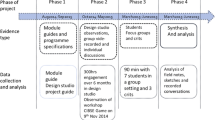Abstract
This paper aims to outline and suggest an alternative pedagogy approach for teaching sustainable architecture theory within a studio-based environment, utilising the pedagogical methods for solving complex problems and applying ‘designerly thinking.’ Emphasising the qualities of a hybrid approach of electives and integration in an architectural education framework. It will reflect on understandings of architectural pedagogy and the integration of sustainability into architectural theory education. Beginning with a discussion of contemporary literature and policy concerning education for sustainability in architecture, it is accompanied by critical understandings of how architects synthesise different types of knowledge while designing, raising questions about the ‘match’ between theoretical educational experiences and subsequent behaviours in practice. Taking an example from Denmark, we outline the approach of Aarhus School of Architecture, where the majority of teaching occurs within design studio courses with short supplementary theory courses each year. During this pilot theory course, a direct observational study was made of 3rd-year architecture student during the two-week theory course on sustainable architecture theory to understand how they engage with the sustainable architecture discourse. The pedagogical approach involved multiple modes of learning including; participating in lectures, readings and documentaries followed by group work producing map**, essay writing, and a final visual representation. The findings emphasise the importance of not only students’ personal critical reflection and active engagement but in order for students to find sustainable architecture theory engaging and relatable to their design practice. Additionally, students need to be supported in gaining different types of knowledge through different modes of learning.
Similar content being viewed by others
References
Altomonte S (2009) Environmental education for sustainable architecture. Rev Eur Stud 1:12
Altomonte S, Rutherford P, Wilson R (2014) Map** the way forward: education for sustainability in architecture and urban design. Corp Soc Responsib Environ Mange 21:143–154
Arkitektskolen Aarhus (2015) Focus areas [WWW Document]. Arkitektskolen Aarhus. http://aarch.dk/info/research/about-research/focus-areas. Accessed 15 Nov 16
Attoe W, Mugerauer R (1991) Excellent studio teaching in architecture. Stud High Educ 16:41–50
Brandt CB, Cennamo K, Douglas S, Vernon M, McGrath M, Reimer Y (2013) A theoretical framework for the studio as a learning environment. Int J Technol Des Educ 23:329–348
Butera S, Astrup TF, Christensen (2015) Environmental impacts assessment of recycling of construction and demolition waste. Technical University of Denmark, Lyngby
Child D (2004) Psychology and the teacher. Continuum, London
Cole RJ (1980) Teaching experiments integrating theory and design. J Architect Educ 34:10–14
Cross N (1982) Designerly ways of knowing. Des Stud 3:221–227
EDUCATE (2012) Sustainable architectural education. University of Nottingham, White Paper
Farmer G (2013) Re-contextualising design: three ways of practicing sustainable architecture. arq: Architect Res Q 17:106–119
Farmer G, Guy S (2009) Pragmatism and the ethics of sustainable architecture. Presented at the ethics and the built environment. University of Nottingham, Nottingham, pp 90–106
Green LN, Bonollo E (2003) Studio-based teaching: history and advantages in the teaching of design. World Trans Eng Technol Educ 2:269–272
Haines C (2010) The role of the architect in sustainability education. J Sustain Educ
Hartman H (2011) The green building agenda is gathering pace but the task ahead is enormous. Architects’ J 234:20
Hillier B (1993) Specifically architectural theory: a partial account of the ascent from building as cultural transmission to architecture as theoretical concretion. Harvard Architect Rev 9:8–27
Hillier B (1998) Space is the machine: a configurational theory of architecture. Cambridge University Press, Cambridge
Kolb AY, Kolb DA (2005) Learning styles and learning spaces: enhancing experiential learning in higher education. Acad Manage Learn Educ 4:193–212
Lawson B (2004) Schemata, gambits and precedent: some factors in design expertise. Des Stud, Expertise in Des 25:443–457
Leroy P, Ligthart S, van den Bosch H, Ligthart S (2001) The role of project-based learning in the “Political and social sciences of the environment” curriculum at Nijmegen University. Int J of Sus in Higher Ed 2:8–20
Levy A (1980) Total studio. J Architect Educ 34:29–32
Mark L (2013) The green curriculum. Architects’ J 238:78–82
Osmani M, Glass J, Price ADF (2008) Architects’ perspectives on construction waste reduction by design. Waste Manag 28:1147–1158
Reinmuth G, Nielsen AG, Toft AE (2011) A beaux arts education for the 21st Century. Architectural Publisher B
Rutherford P, Wilson R (2006) Educating environmental awareness: creativity in integrated environmental design teaching. 40th Annual Conference of the Architectural Science Association ANZAScA. Presented at the Challenges for architectural science in changing climates. Adelaide School of Architecture, Adelaide, pp 261–269
Sevaldson B (2012) GIGA-map** [WWW Document]. Systems oriented design. http://www.systemsorienteddesign.net/index.php/giga-map**. Accessed 12 Oct 2016
Turkienicz B, Westphal E (2012) The cognitive studio: exercises in design learning. In: Sha** design teaching: explorations into the teaching of form. Aarborg University Press, pp 185–202
United Nations (2015) Transforming our World: The 2030 agenda for sustainable development (No. A/RES/70/1)
Unknown (2013) How to teach sustainable design. Architects’ J 238:83–85
Unterrainer W (2015) Sustainability: an imperative for plurality and context. In: Sustainability: an imperative for plurality and context. Arkitektskolens Forlag, Aarhus, p 7
Van der Ryn S, Cowan S (1996) Ecological design. Island Press
Wenger E (2000) Communities of practice and social learning systems. Organization 7:225–246
Author information
Authors and Affiliations
Corresponding author
Editor information
Editors and Affiliations
Rights and permissions
Copyright information
© 2018 Springer International Publishing AG
About this chapter
Cite this chapter
Donovan, E. (2018). Sustainable Architecture Theory in Education: How Architecture Students Engage and Process Knowledge of Sustainable Architecture. In: Leal Filho, W. (eds) Implementing Sustainability in the Curriculum of Universities. World Sustainability Series. Springer, Cham. https://doi.org/10.1007/978-3-319-70281-0_3
Download citation
DOI: https://doi.org/10.1007/978-3-319-70281-0_3
Published:
Publisher Name: Springer, Cham
Print ISBN: 978-3-319-70280-3
Online ISBN: 978-3-319-70281-0
eBook Packages: Earth and Environmental ScienceEarth and Environmental Science (R0)




